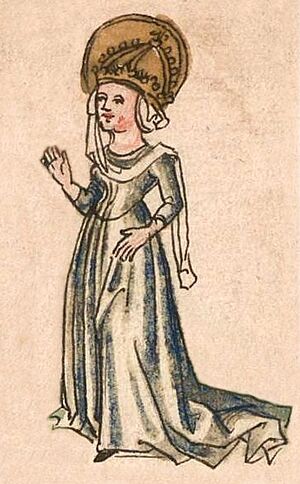Hildegard (queen) facts for kids
Quick facts for kids Hildegard |
|
|---|---|

Hildegard in an illustration from about 1499
|
|
| Queen of the Franks | |
| Reign | c. 771 – 30 April 783 |
| Successor | Fastrada |
| Queen of the Lombards | |
| Reign | June 774 – 30 April 783 |
| Predecessor | Ansa |
| Successor | Fastrada |
| Born | c. 757/758 |
| Died | 30 April 783 Thionville |
| Burial | Abbey of Saint-Arnould, Metz |
| Spouse | Charlemagne (m. c. 771) |
| Issue | Charles the Younger Pepin of Italy Adalhaid Rotrude Louis the Pious Lothair Bertha Gisela Hildegard |
| Father | Gerold of Anglachgau |
| Mother | Imma of Alemannia |
Hildegard (born around 757 or 758, died April 30, 783) was a powerful Frankish queen. She was the wife of Charlemagne, one of the most famous emperors in history. They were married for about eleven years, starting around 771.
Hildegard came from a noble family with both Frankish and Alemannian roots. During her marriage, she played an important role alongside Charlemagne. She also had nine children with him. Among their children were future kings, including Charles the Younger, Pepin of Italy, and the emperor Louis the Pious.
Contents
Life as a Queen
Hildegard was the daughter of Gerold, a Frankish count, and Imma, an Alemannian noblewoman. Historians believe her mother, Imma, came from a very important family. She was likely born in 757 or 758.
Marriage to Charlemagne
Hildegard's father, Gerold, owned land near the Middle Rhine river. This area was part of the Frankish kingdom. In 771, the Frankish king Carloman I died. His brother, Charlemagne, wanted to take control of Carloman's lands.
To gain Gerold's support, Charlemagne decided to marry Hildegard. They married soon after Carloman's death, probably before April 30, 772. Hildegard was only about 13 or 14 years old when she became queen. This marriage also meant Charlemagne ended his previous marriage.
As queen, Hildegard had many important duties. She was in charge of managing the royal household and the king's lands. She also signed official documents with her husband, like grants to monasteries.
Life in the Royal Court
Charlemagne brought Hildegard to the royal palace at Thionville. They stayed there for two months before Charlemagne left for a military campaign. When he returned, their first son, Charles the Younger, was born in Thionville.
While at Thionville, Charlemagne received a message from Pope Adrian I. The Pope asked for Charlemagne's help against the Lombard king. Charlemagne agreed and invaded Lombardy in late 773. He surrounded the Lombard capital, Pavia.
In early 774, Hildegard traveled to the Frankish camp at Pavia. She was pregnant at the time. During the siege, she gave birth to a daughter named Adelhaid. Sadly, the baby died on the way back to Francia. By June, Charlemagne had won the battle. He became king of the Lombards. Charlemagne and Hildegard likely had a special ceremony in Pavia as the new king and queen.
Royal Travels and Children
The royal family returned to Francia in the summer of 774. The next year, Hildegard gave birth to their daughter Rotrude. Their son Carloman was born in 777.
In 778, Hildegard joined Charlemagne in Chasseneuil-du-Poitou. He was gathering his army for a campaign in Spain. Hildegard was pregnant and gave birth to twin boys, Louis and Lothair, while Charlemagne was away. Sadly, Lothair died at age two. In the same year, Hildegard had another daughter, Bertha.
In 781, Charlemagne and Hildegard traveled to Rome with their children Louis and Carloman. Pope Adrian I had asked them to come. Carloman was four years old, and his parents wanted the Pope to baptize him. The Pope baptized Carloman and renamed him Pepin. This meant he shared a name with his older half-brother.
Pope Adrian then crowned Carloman (now Pepin) as king of the Lombards (later called king of Italy). He also crowned Louis as king of Aquitaine. These young kings were sent to their new kingdoms to be raised by special advisors. During this trip, Hildegard also gave birth to her third daughter, Gisela. She was baptized in Milan.
Around this time, Hildegard and Charlemagne ordered the creation of the Godescalc Evangelistary. This is a beautiful illuminated manuscript (a handwritten book with decorations). It is a great example of Carolingian Renaissance art.
Hildegard's Death
Hildegard had her last pregnancy in 782–783. She and Charlemagne stayed at the palace in Thionville that winter. Hildegard gave birth to another daughter in late April. However, she died soon after, on April 30, 783. She may have died from problems after childbirth. The baby girl was named Hildegard, after her mother. But she also died less than two months later.
Hildegard was buried at the Abbey of Saint-Arnould in Metz. Charlemagne made sure her tomb would always be lit. He also arranged for daily prayers to be said for her. He even asked a court writer, Paul the Deacon, to write a special poem in her honor.
Children of Hildegard and Charlemagne
Hildegard had nine children with Charlemagne:
- Charles the Younger (born around 772 or 773, died 811). He became a duke and king under Charlemagne.
- Adalhaid (born 773 or 774, died 774). She was born during a military campaign in Italy. She died on her way back to Francia.
- Rotrude (or Hruodrud) (born around 775, died 810).
- Carloman, renamed Pepin (born 777, died 810). He became King of Italy.
- Louis (born 778, died 840). He became King of Aquitaine and later Emperor.
- Lothair (born 778, died 779 or 780). He was Louis's twin brother but died as a baby.
- Bertha (born 779 or 780, died 826).
- Gisela (born 782).
- Hildegard (born 782, died 783).
Louis and Pepin both married and had children. Rotrude was once planned to marry Emperor Constantine VI, but this plan was canceled.

